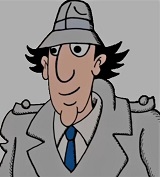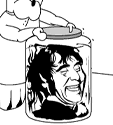|
I haven't even played 5e but I think this happens when GMs imagine how their epic encounters will go, with their cool bosses, and then because they imagined this guy as a loner there's no minions, or they imagined this guy as a dark sorcerer so wisdom was a dump stat, etc. encounter design is hard, like, it's a skill that takes time and practice, and like all kinds of skills, it's not just 'practice makes perfect' it's 'perfect practice makes perfect' but D&D gives GMs the extremely dangerous tool of GM fiat, and if you start practicing your encounter design as an exercise in changing the rules instead of an exercise in discovering how to get what you want within the rules that exist, you'll never actually learn how to design encounters well In much older editions of D&D I was bad at encounter design for a long time (as a teenager for example) because I'd fudge dice rolls behind the screen, generally to benefit the players, which meant instead of giving them level-appropriate encounters or even just figuring out what this particular party was good or bad at, I was just picking whatever fit my imagination (there's a minotaur in this maze) and then the players would just defeat it by it whiffing more attacks, having suddenly fewer hit points, failing saves, etc. The players never knew what the real stats were supposed to be, I didn't have a bunch of monster manual studiers, so it sorta "worked" but it did not actually work to develop my skill as a GM. I got over it in particular with 3rd edition when I think the game was better balanced, and while building NPCs and enemies in 3rd edition was stupidly time-consuming, I had a much better grasp of what the math was going to look like. in conclusion my advice would be to be understanding about your GM's lack of skill and/or experience leading them to make bad rules decisions, they're reacting to what they perceive as game imbalances rather than having a good-GM skill of building enemies and encounters that will be both challenging and winnable for your party. Unless they're one of those GMs who just think the party should lose to their special bad guy, in which case, uh, they do not understand what this game is about.
|
|
|
|

|
| # ? Jun 3, 2024 23:57 |
|
This is a long shot, but does anyone know of a The Bachelor-themed one shot? I'm trying to do something for Valentine's Day for people who have never played D&D before, but like The Bachelor a lot.
|
|
|
|
GoGoGadget posted:This is a long shot, but does anyone know of a The Bachelor-themed one shot? I'm trying to do something for Valentine's Day for people who have never played D&D before, but like The Bachelor a lot. If you come on over to the GM advice thread and ask there, the folks there are amazing at coming up with ideas
|
|
|
|
Thanks for the advice. I'll be patient and give him time.
|
|
|
|
Leperflesh posted:encounter design is hard, like, it's a skill that takes time and practice, and like all kinds of skills, it's not just 'practice makes perfect' it's 'perfect practice makes perfect' but D&D gives GMs the extremely dangerous tool of GM fiat, and if you start practicing your encounter design as an exercise in changing the rules instead of an exercise in discovering how to get what you want within the rules that exist, you'll never actually learn how to design encounters well Let's imagine a simplified version of D&D where the enemy just has hit points - and let's say that for this session the GM just wants to design a "close fight": 1. The GM has the brain the size of a planet, knows the players, and is able to run a mental simulation of the encounter 1000 times. He picks a number of hit points such that he expects players will win 90% of the time, but it will be in the "close fight sweet spot" about 85% of the time. 2. The GM is less experienced, and likely to underestimate or overestimate the party's abilities - but once he's decided a number he treats it as sacred. Sometimes a "meant to be close" encounter ends in a wet fart where the party stomps despite bad rolls and tactics. Other times the party is unceremoniously wiped despite good tactics and rolls. And the players have a less good experience, because the GM screwed up and was unwilling to significantly put their finger on the scale. 3. The GM feels free to make up or change hit points as they go along, and to add or remove enemies and events. If rolls go really well for the party, and they're doing clever things, maybe they let the party have a stomp. Feel powerful and cool. Sometimes they allow a disaster where it wasn't close, especially when people are rolling bad, weren't prepared, or not putting in effort. When things are going "normally", they don't deviate much from their HP guess - but they might time the end of the fight around a dramatic moment or unexpected tactic or success. Or let the party finish dying if they got "close but not quite" and couldn't get those last hits in. How do players distinguish between situation 1 and 3? Why is it so important to shoot for 1? Why does the GM have to stay committed to their design if it's not working? What's so "dangerous" here? To me it just seems like it's about GM ego - like, "wow, I didn't have to change a thing to make this encounter perfect - I just built the perfect machine and let it run". Or player ego - like, they want a guarantee that they're objectively "winning", not relying on GM charity or something. I understand that in some sense or scenario, if you are playing Gloomhaven, or were trying to play some set competitive scenarios or something... but if it's just a random session where the GM is designing stuff ad hoc... then how would they know whether the GM added an extra werewolf when it turned out 3 wasn't enough? And how is that different from the situation where the GM knew they'd need that werewolf before the game started? How happy are these players when their campaign ends in an anti-climactic wipe, and the GM says "well, sorry, I didn't realize how strong I made those guards, but I know how you guys don't want me to baby you". Seems like the flexible GM (#3) provides a much better game experience than "wannabe #1" GM (#2). Edit: to be clear... I think you should just stay at #3 forever. Over time, you'll get better at designing experiences - you'll be more like #1 in practice, and you'll need to do less "cheating", and make smaller changes. But I don't see why you should ever lose your willingness to cheat a bit. You should never decide that you're so good at encounter design that you aren't willing to fix something while you're in the air. jmzero fucked around with this message at 18:35 on Feb 8, 2024 |
|
|
|
Sure, if you ignore the context of the discussion, which is a GM changing player-facing rules by restricting what character powers are or what they're allowed to do. If you're only talking about GM-facing, hidden rules like monster HP or adding a couple new combatants to an encounter midway, you're not actually addressing the point. Travic posted:Might be this. Dm has changed a few things before to slow things down. He didn't like my healing so he switched us to 36 hour long rests and instituted material components to stop/slow restoration spells. Also made mobs immune to crowd control. This is a GM that is adjusting encounter difficulty by taking away the player's tools for defeating the enemies they're facing, instead of adjusting the enemies they're facing - before hand or on the fly. I do think it's better to give the GM tools to design challenging but not overwhelming encounters, and good, well-balanced games do that. Including D&D, at least in previous editions. It's also important for the GM to learn what the players can do - instead of removing crowd control options, or multi-day long rests, or whatever. e. Also I do think a GM probably needs to pass through your #2 phase, to get better. At least a little. It's OK to stop the game and say "OK guys I screwed up, this encounter is too hard and is gonna wipe the party. Let's fix that." IMO that's better than just wholesale changing the game's rules. Yes, tweaking hit points might be smoother, but it's a poor habit to fall into as a substitute for getting to #1, ever. You've framed your argument as #1 being an impossible goal, which makes #3 the only real option for a good play experience, and I reject that framing. Leperflesh fucked around with this message at 18:33 on Feb 8, 2024 |
|
|
|
I also think that being aware of the state of the battle from turn to turn to be able to tune it will also make you better at setting up an encounter from the start that naturally does what you want it to. This game pretty much all comes down to damage per round and being more hands on about it can help you conceptualize the math going on. But changing poo poo on the fly to suit your players is like, one of your most fundamental powers as a DM that you're loving up if your ignoring.
|
|
|
|
I'll repeat that I think that's OK, although it's a part of a feedback loop into future encounter designs. You know you had to fudge a bunch that last encounter, the next one you design for this party at this level can be a bit tighter. But that's again categorically different from taking away player abilities.
|
|
|
|
Leperflesh posted:Sure, if you ignore the context of the discussion, which is a GM changing player-facing rules by restricting what character powers are or what they're allowed to do. To me, the relevant context I was addressing was in your post, where you were talking about things you used to do: Leperflesh posted:In much older editions of D&D I was bad at encounter design for a long time (as a teenager for example) because I'd fudge dice rolls behind the screen, generally to benefit the players, which meant instead of giving them level-appropriate encounters or even just figuring out what this particular party was good or bad at, I was just picking whatever fit my imagination (there's a minotaur in this maze) and then the players would just defeat it by it whiffing more attacks, having suddenly fewer hit points, failing saves, etc. So yeah, you tweaked hit points and encounters on the fly, and you're presenting that in a negative light. It seemed to me like you were saying "don't be willing to disappear some HP, or else you'll never learn", while I think most GMs should be willing to do exactly this kind of thing. And yeah, obviously it's better if you don't have to do that. But when you did this kind of stuff, it probably made "that session" a better experience for your players than if you hadn't... and it didn't stop you from getting better at designing encounters over time. You still learned the same lessons, you just didn't make your players pay for it. quote:You know you had to fudge a bunch that last encounter, the next one you design for this party at this level can be a bit tighter. But that's again categorically different from taking away player abilities. Yep, sure. And I didn't mean to comment on a broader range of "dicking around with players" or changing rules. And I'd agree normally those should be out of scope - there should be enough hidden dials to tweak that you don't need to be cranking player visible ones. (or you should be doing so between games as a meta-discussion, if something is causing one player to dominate the table or whatever). Edit: also, I've been spending too much time on Reddit, and my tone has crept further towards "toxic rear end in a top hat". Sorry. jmzero fucked around with this message at 18:59 on Feb 8, 2024 |
|
|
|
Imo, always be GM #3. Make the big bad a big pool of HP, make his minions take 1-3 hits, and when the dramatic moment is over and it's mop up time, let every mob surrender, die, or be incapacitated in one hit so it doesn't drag on. Add in creatures, environmental factors, reinforcement waves, or time pressures like a prisoner to save from execution or a maguffin item/ritual/etc. that needs to be stopped before it's too late. My rule of thumb for my party is to go well into what Challenge Rating would call deadly, with maximum HP (the hit die are usually listed for a monster) on the key monster, and half or less on their minions, and maybe double the quantity of minions. This action economy change makes the first 1-3 turns feel really sketchy and tenuous for the players as they're overwhelmed by small creatures, but it lets them feel like all the weaklings they clear quickly have a big impact on the fight. Giving the main monster a lot of hit points let's it pressure the players if they ignore it, but if all the minions are dead and it's used most of it's cool unique abilities, I'll let them drop it quicker and drop its HP or just roll a save dice and say it failed no matter what the die says. This usually develops into the barbarian squaring up with the big creature, while the monk and warlock clear the adds, and the sorcerer and bladesinger wizard use their toolkit to either focus the big bad down, clear a big wave of minions, or help shape the battlefield through their utility spells. For single creatures or where you only have 2-3, you've got to give them extra lair actions, special reactions, unique effects that are well telegraphed that players can interrupt or avoid but are devastating if they hit, and give them extra maneuverability options. Matt Colville really helped shape my combat DM style with his action oriented monsters, and my players seem to like it  . You'll notice, nowhere did I have to nerf a player character's CC abilities, healing, or anything like that. I love the cool character's my players made, and I wouldn't ever want to make them less awesome. What you have to do is make the encounters that they're facing scale to their capabilities so that they can show off how awesome they are and feel like they earned it. . You'll notice, nowhere did I have to nerf a player character's CC abilities, healing, or anything like that. I love the cool character's my players made, and I wouldn't ever want to make them less awesome. What you have to do is make the encounters that they're facing scale to their capabilities so that they can show off how awesome they are and feel like they earned it. https://www.youtube.com/watch?v=y_zl8WWaSyI https://www.youtube.com/watch?v=QgTIGo6zJbs https://www.youtube.com/watch?v=QoELQ7px9ws
|
|
|
|
jmzero posted:To me, the relevant context I was addressing was in your post, Well, yeah, I conflated two things I guess. Sorry. I did not get better at picking monsters because I habitually tweaked the HP, instead of using that info to inform my choices. I was also playing AD&D, and a big part of that game is players avoiding encounters, so part of the adjustment I needed to be making was helping my players find noncombat ways to get past encounters, etc. which I was also not really doing because I didn't get that that was baked into the design. What I meant to show was that a GM needs to learn by process and get better, and here's an example of that (me not doing that, specifically): and then, separately, a GM should not be taking away player abilities habitually as a way of avoiding or refusing to get better at encounter design. e. I guess a side thing is that if a game's math is off and encounters turn into a slog, fix the game design. 4e had terrible math on publication for some kinds of monsters, and they had to release a patch basically, but that genuinely helped and running 4e games late in that edition I did not need to adjust or fudge monster hit points. I don't want to turn this into an edition war, but if you just need to apply a .9x modifier to brutes' HP across the board, do that. Leperflesh fucked around with this message at 18:50 on Feb 8, 2024 |
|
|
|
I'm glad that you brought up 4E's monster math and how it changed because iirc the monster math wasn't "wrong" the way the early skill challenge math was, but the formulas used were based around some wrongheaded assumptions about how long a fight should last, so monsters had too many HP and didn't hit hard enough for most players' tastes. I mention that because, even if I'm misremembering and the formulas were straight up incorrect, player taste is an important part of what you should be adjusting for when designing or revising encounters. One group may prefer fights that are quick and dirty and over in 3 rounds or less with the tension coming from "rocket tag" where combatants are dropping left and right. Another group may prefer fights that develop over 4-6 turns with the tension coming from tactical positioning and setting up synergies and combos. A third group may want most fights to be short and brutal except for boss fights that should instead be epic session stoppers. (As an aside, I think some of the good faith critiques of 4E were the result of it catering more to the second group, especially with its early sloggy math.) You can be jmzero's DM1 and still design a poo poo encounter for your players because it's a perfect mathematical challenge of their characters' abilities and their own intellect, but it's also an encounter that felt insignificant and cursory or an encounter that felt like it ate up the entire session, and either way the party found it boring.
|
|
|
|
There's a lot of variables. I think my general rule of thumb is that if the PCs curb-stomp what was meant to be an impressive encounter, they should be allowed. If, through luck or bad decisions, my forces are curb-stomping the PCs, then I try to do what I can to mitigate and allow them to either flee or recover, but that happens rarely in 5E because it's a pretty forgiving system after the first few levels and if you use anything close to their CR guidelines, encounters will typically be easier than you estimate (with exceptions for things like Intellect Devourers, Mind Flayers, enemies with mind-control, etc). The left-over bits of the old-school "adversarial DM" and the related "simulationist play" mean that players may get dissatisfied if encounters are constantly too hard and you constantly allow them to win or get out of a too-tough encounter, because nobody wants to win because you cheated for them (beyond a point). If you're very "it's a story and this isn't very fun if the story ends because you kept hitting that black pudding with slashing attacks" then everyone is likely to be more understanding, and even more so if you're running home-brew monsters without a lot of experience. But whether or not you're thinking simulation, story, or something else, it's also a-OK as a DM to have the players win a big battle more easily than you expected. I ended a 7-year campaign that spanned 2E and 3E, with PCs having levels in the 30s by the end of it, with a climactic fight against an imprisoned deity who appeared in five different forms the PCs had to defeat, while also having sets of minions and existential threats to pull out as distractions or plays for revenge. But over the course of about a full year of real time, the players had systematically worked to eliminate (or in one case, convert) the deity's followers and allies, gather support, and had also unexpectedly ended up deifying one of their number (he became the new death god, replacing a deity that had been allied with their ultimate foe). The nature of the fight did mean it took two sessions to complete, and it wasn't precisely a curb-stomp, but it was a much easier fight than many others they'd fought earlier in the campaign. Some of the minions lasted longer than the big bad's forms, because the PCs were just screening them off and concentrating on the big bad, which was good tactics. They'd earned an end fight that wasn't actually as desperate as many battles they'd fought before, and IMO the campaign ended better because it acknowledged how far they'd come, to the point that they could handle a threat this big handily. That's despite the fact that I felt, at the time, like it was a bit of an anti-climax. The players didn't, and that's what matters.
|
|
|
|
Anyone here have experience with the Planescape adventure, "Turn of Fortune's Wheel"? I'm playing through Planescape: Torment and it got me interested in maybe picking this up.
|
|
|
|
I'm always kinda miffed when my players trivialize boss encounters but on the other hand a DM should be their players' biggest cheerleader and be proud when they pull off some poo poo that he did not take into account when designing an encounter. On the note of magic items: 5e feels designed around players getting magic items but the DMs guide is written like handing them out is the worst thing ever and buying them should be punished. It also begs the question why attunement exists if you never get enough items to pick and choose anyway. Just buying a supplement like discerning merchant's price guide and maybe even showing it to the players solves a lot of these problems. Now players can save their monies for something they really want or pool resources to buy cool poo poo. Or the DM can curate a list from that to ease some decision paralysis for the players. Either way, it should be a given. Edit: My current house rule for resting is to give out short rests after every fight automatically and allow long rests after 4 encounters. It is currently in its testing stage but feels like it incentivises the management of resources without too much tedium. Rubberduke fucked around with this message at 13:18 on Feb 9, 2024 |
|
|
|
Rubberduke posted:On the note of magic items: 5e feels designed around players getting magic items It is not.
|
|
|
|
Rubberduke posted:I'm always kinda miffed when my players trivialize boss encounters but on the other hand a DM should be their players' biggest cheerleader and be proud when they pull off some poo poo that he did not take into account when designing an encounter. Our current DM decided a while back to not let me catch an arrow as a monk because he crit - I'd specifically positioned myself to be a nearer target than our mage, we rarely deal with archers and I never remember I have deflect missiles, anyway, but he still shut it down. His reasoning was 'how would you feel if you got a crit and I shut it down,' but that's not what happened, I just negated the damage. That's a particularly bad example, and he's not done anything specifically petty like that in a while, but I'm sort of running up against a wall creatively with him. I don't chime in much any more, because whenever I try and do something interesting, he either shuts it down or responds in character / in universe in a really hostile way. So I just kind of RP by numbers now because of it.
|
|
|
|
Rubberduke posted:I'm always kinda miffed when my players trivialize boss encounters but on the other hand a DM should be their players' biggest cheerleader and be proud when they pull off some poo poo that he did not take into account when designing an encounter. On player side the occasional Boss Stomps can be memorable too. One really fun boss stomp was in a Ravenloft module, where we encountered Baba Yaga and his Chicken legged hut. The Baba Yaga Hopped on a floating platform out of reach of the party ready to activate her hut as her first action. Except The wizard (me) rolled really high initiative and cast Paralyze on her. She failed to save. Warlock gave flight to the groups Paladin who flew up in the Sky and smote her down. She failed her 2nd paralyze save and got wrecked by the party without ever getting do anything else than her opening villain monologue.
|
|
|
|
YggdrasilTM posted:It is not. Eeeeh I feel like this is at least generally true most of the time. Because depending on your adventure/encounter design, magic items help a lot in closing the gap.
|
|
|
|
It's designed against players getting fewer magic items than previous editions were, at least
|
|
|
Bobby Deluxe posted:His reasoning was 'how would you feel if you got a crit and I shut it down,' Thatís incredibly lame, Iíd be jazzed and would talk it up as an even more impressive scenario. Itís the perfect shot with the even more perfect block. Itís the rocket league game-winning epic save out of nowhere. Itís the slow motion dive in front of the bullet to take the shot in grandfatherís watch in your breast pocket. Itís Kurt Russel unceremoniously throwing the knife back. What Iím saying is, gently caress that.
|
|
|
|
|
Dallan Invictus posted:It's designed against players getting fewer magic items than previous editions were, at least I think that the game does a better job than previous editions, where the monster math would break without having a fiddly +1 or +2 at certain intervals. But now I think you should put in magic items because the game is really boring without them.
|
|
|
|
YggdrasilTM posted:It is not. Maybe it is, but poorly. Also, every official adventure hands out magic items fairly early. I know it wasn't balanced around it, but the rest of the game doesn't seem to care about that.
|
|
|
|
YggdrasilTM posted:It is not. Eh, they say that, but then almost a third of the DMG is dedicated to magic items, and they do this big song and dance over how you can't buy magic items and then give you functionally nothing on which to spend the money the game recommends DMs give out. Every published adventure for the game hands out multiple magic items. And if the game wasn't designed around players getting magic items, it wouldn't be necessary to put a cap on the number of items players can attune to, since the intended number of items for a player to get would be zero. And significant portions of the monster manual feature enemies that are resistant or even immune to non-magical weapons, and I cannot seriously entertain the notion that when placing these monsters into the game the designers were thinking "we're expecting weapon users to be completely unable to harm these creatures" as opposed to "we're expecting weapon users in most cases to have magic weapons by the time they face these creatures". The only part of the game I think we can say isn't designed with the expectation that players are getting magic items is the CR encounter maths, which is possibly the worst designed part of the entire rules.
|
|
|
|
The game is not built with the assumption characters will get Magic Items, but Magic items are recommended. They are meant to be purely a bonus rather than something the players need to keep up.
|
|
|
|
Reveilled posted:Every published adventure for the game hands out multiple magic items. In my experience, the modules contain very few magic items, and I find myself adding a bunch because magic items are cool.
|
|
|
Yusin posted:The game is not built with the assumption characters will get Magic Items, but Magic items are recommended. They are meant to be purely a bonus rather than something the players need to keep up. Wait are we still talking about 5e Because there is absolutely an assumption that martial characters will get a magic weapon by about level 6
|
|
|
|
|
Hieronymous Alloy posted:Wait are we still talking about 5e tbh I think the actual assumption at WotC is "nobody plays martial characters"
|
|
|
|
Yeah I don't know how you can say with a straight face the game doesn't expect you to have a magic weapon as a martial by Level 6 when the Monk, literally one of the least-favored classes in 5e, textually gets that as a freebie. If you're at Level 6 and you don't at least have a bog-standard +1 Weapon Of Choice by now your DM is being aggressively stingy. The game is definitely meant to have less magic item fuckery than, say, 3e, which isn't surprising because every endgame 3e character was walking around with like 12 different magic items equipped + probably a couple Wondrous Items that they didn't have to equip. But to say you can entirely low/no-magic item your way through the game is just blatantly untrue for non-casters.
|
|
|
|
|
I've been trying to fit more magic items into my 5E, and I think being careful what kind of items I give players lets me give them out a little more freely. I had been hiding magic items in cool places that reward exploration or clever problem solving and my party had just been bulldozing through everything in front of them and missing most of it. The ah-ha moment was when the party ran into a boss that could only be damaged with magical weapons and only one of them had one. They were NOT supposed to be actually fighting with that rakshasa yet, but they blundered their way into it and it got ugly. They managed to escape and level up to lvl6 and when they got the dwarven capitol where one of the players is a noble shortly threafter I just told them "If you don't have a +1 weapon, you get one here." Now I'm just putting fun little magic items on more of the "leader" monsters in normal encounters. They most recently got a key that fits into any lock. It only ever locks every door/chest/etc you turn it in. It'll be great to see them figure it out and then use it creatively. I really want to give them the bagpipes of invisibility as a gag item. As long as you're playing them, you're invisible. Not inaudible. That's all they do. I'll give them stuff with charges to expend on a handful of reasonable effects like Gem of Brightness, or just scrolls. As long as they aren't hoarding them all it makes it easy enough to throw magic items around without breaking the game. This also plays into my encounter design too. Having a decent supply of consumables makes me more comfortable putting the party in difficult situations/encounters knowing they have extra tools they can and should use. Not having to use them makes victory sweeter for them, and getting extra fun and powerful effects that allow them to overcome seemingly overwhelming odds or impossible situations also feels good for them. I definitely err on the side of harder encounters I can fudge a little behind the screen, which plays into this too. I'll often introduce enemies to the fight in waves; "the sounds of your battle reach ears of the guards in the next watchtower, and they charge down the ramparts to join the fray." If the fight is going too badly, reinforcements just never arrive and no one needs to know. If things are too easy it doesn't seem weird for more enemies to pop up out of nowhere, though I certainly don't make easy encounters harder for no reason all the time. I really like the flexibility of making fights develop in stages gives me as a DM and my players have told me they like how it creates a sense of tension in encounters and makes them more dynamic. Since the party usually ignores the opportunity I like occasionally having bonus challenges with slightly overpowered items as rewards. As a reward for playing with puzzle mechanics some more after solving the main puzzle, the party got a +2 dagger really early on in the campaign. However, it's intelligent and very vain, so the user gets three chances a day to flatter it appropriately and have it be a +2 (until long rest) before it just sulks and only deals 1 bludgeoning damage (until long rest). They recently found a strange shrine in a dangerous and secluded cavern series off of some "abandoned" gemstone mines. If they had gone through with the puzzle they would have ended up with a Ioun Stone of Insight. Or died to poison gas and angry doppelgšngers. But the opportunity was there, and the party have noted the suspicious shrine as something to come back to. Something I put into my custom items ages ago is the Impervious Comfort Gown (name taken from a piece of PPE I wear at work). While wearing it, your comfort is impervious. Popular amongst stuffy tower mages who rarely leave the library and don't wish to be distracted in their study. The attuned wearer is convinced of the practicality and fashionability of the the gown at all times, and always feels like it's their ideal temperature and humidity, outside of extreme situations. There's some very minor damage reduction to fire and cold damage, but it can be increased in finer examples. They also lose all bonuses to perception checks regarding environmental conditions like temps, wind, etc. In particularly fine examples they might get better damage reduction bonuses in exchange for perception penalties, and even be unable to accurately gauge the amount of damage they're really taking. The last part sounds like a lot of bookkeeping on my part, but it also sounds funny to me for at least one session or so. Maybe getting attunement is just wearing it and learning how to notice you're being injured and then that effect goes away. Players have noticed that it's available while perusing mundane magical items, and I know at least one of them really wants one so I think I'm going to find more places to put one for them to find. The idea of the party rogue wearing a big fluffy bathrobe over her armor at all times so she's comfy is hilarious.
|
|
|
|
Yusin posted:They are meant to be purely a bonus rather than something the players need to keep up. I don't think this is really true, but if it is then it means 50+% of your fighter's damage output is determined by how many "fun little optional bonuses" the GM feels like giving you
|
|
|
|
YggdrasilTM posted:It is not. I can't find it right now but I've seen some pretty comprehensive analysis looking at average monster AC by level that strongly suggests that average monster AC grows by 1 point every other level, i.e. exactly half as much as it did in 4e. This also means that your PC's attack should also grow by about 1 point every other level to keep up, unless you consider it intentional that weapon-using classes should fall behind over time at doing the one thing they're meant to be good at, in addition to everything and everywhere else. Over 20 levels, your proficiency bonus grows by 4, from +2 to +6, and you can also fit in another +2 to your main stat from ASI (but not more, because it should start at 16-17 and gets capped at 20!), which leaves a shortfall of 4 points that's almost exactly covered by a +3 weapon. And this doesn't even go into the can of worm-monsters that have resistance or immunity to magic weapons, which can show up at shockingly low CR as well. You could say that specific magic weapons with specific unique qualities are a bonus, but vanilla +X weapons really are not; I think I remember the same person reverse-engineering the random loot table to "expect" a significant, non-consumable magic item every 4 or so levels, which again is about the right pace to get weapon upgrades to keep up with the curve. Incidentally, while casters can also get magic items to boost their Save DCs, this issue doesn't affect them half as much, because non-proficient Saving Throws don't even scale with proficiency! So at worst they can keep pace when targeting strong saves, and at best can massively overscale if they target weak saves.
|
|
|
disaster pastor posted:tbh I think the actual assumption at WotC is "nobody plays martial characters" Paladins are technically martials
|
|
|
|
lightrook posted:I can't find it right now but I've seen some pretty comprehensive analysis looking at average monster AC by level that strongly suggests that average monster AC grows by 1 point every other level, i.e. exactly half as much as it did in 4e. This also means that your PC's attack should also grow by about 1 point every other level to keep up, unless you consider it intentional that weapon-using classes should fall behind over time at doing the one thing they're meant to be good at, in addition to everything and everywhere else. Over 20 levels, your proficiency bonus grows by 4, from +2 to +6, and you can also fit in another +2 to your main stat from ASI (but not more, because it should start at 16-17 and gets capped at 20!), which leaves a shortfall of 4 points that's almost exactly covered by a +3 weapon. . I thought about getting into all this math in my post above but it would have meant effort, thank you for being the nerd I wasn't willing to be Also this is why warlocks get rod of the pact keeper so their eldritch blast keeps pace More fundamentally though: the monster manuals above level 6 or so are filled with monsters that can only be hurt with magical weapons. Including lots of standard encounter type things like were-anythings, vampires, etc. If you're playing d&d above level six and don't have magical weapons shits gonna get real fuckin lame real fuckin fast when you can't do poo poo to anything
|
|
|
|
|
lightrook posted:I can't find it right now but I've seen some pretty comprehensive analysis looking at average monster AC by level that strongly suggests that average monster AC grows by 1 point every other level, i.e. exactly half as much as it did in 4e. I feel like this canít be true cause Monster AC is kept in a very narrow area. Barely any monsters have AC over 20 and tons of low level monsters have AC on par or better than many high level ones.
|
|
|
|
Yusin posted:I feel like this canít be true cause Monster AC is kept in a very narrow area. Barely any monsters have AC over 20 and tons of low level monsters have AC on par or better than many high level ones. It bugged me not having any hard evidence, and it looks like they really did course-correct their newer content to scale "correctly," with the median monster gaining 6 AC over 20 levels, which keeps up with +4 from proficiency and +2 from ASI. I still don't think this really proves that magic weapons are "optional," because without some kind of extraneous bonus, your turns to kill an equal-CR monster only go up over time, and I don't think that's an intended result either, unless you consider it normal for fights to grow exponentially in real-world playtime, from complexity growth on top of increased turn count.
|
|
|
|
Issaries posted:On player side the occasional Boss Stomps can be memorable too. Just finished Sunless Citadel and we got Belak largely because our impatient Chaotic Good Dwarf Warlock just started blasting him with Witch Bolt in the middle of Belak's Bond villain speech. Belak rolled so badly that he never managed to escape the theoretically pretty lovely spell and just died while our Paladin used a potion of fire breathing to burn down The Tree and I, the party Barbarian, kept the swarm of tree blights bogged down. We were sure we were totally hosed but we came out barley scratched. Basically 
FreudianSlippers fucked around with this message at 22:16 on Feb 11, 2024 |
|
|
lightrook posted:It bugged me not having any hard evidence, and it looks like they really did course-correct their newer content to scale "correctly," with the median monster gaining 6 AC over 20 levels, which keeps up with +4 from proficiency and +2 from ASI. I still don't think this really proves that magic weapons are "optional," because without some kind of extraneous bonus, your turns to kill an equal-CR monster only go up over time, and I don't think that's an intended result either, unless you consider it normal for fights to grow exponentially in real-world playtime, from complexity growth on top of increased turn count. Interesting. Doesn't really change the "trying to play Strahd but don't have a magic weapon to damage the vampires" issue, tho.
|
|
|
|
|
I use the Persuade skill to make Strahd think this sword is a Holy Avenger.
|
|
|
|

|
| # ? Jun 3, 2024 23:57 |
|
The Holy Pretender: A sword with a +2 on all attack and damage rolls, until you discover that it isn't actually a magical sword. Then it loses all special qualities.
|
|
|






































